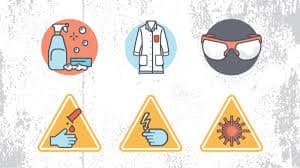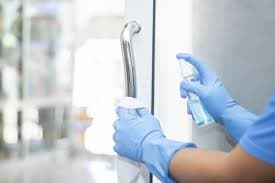Share this
4 steps you should follow when reopening your research lab
by Neoteryx Microsampling on Jul 10, 2020 9:00:00 AM
 Local governments and states implemented restrictions to reduce transmission of the deadly coronavirus known as SARS-CoV-2, which causes COVID-19 illness. Their early efforts paid off; the curve flattened in May/June 2020.
Local governments and states implemented restrictions to reduce transmission of the deadly coronavirus known as SARS-CoV-2, which causes COVID-19 illness. Their early efforts paid off; the curve flattened in May/June 2020.
As businesses and organizations reopen and we see a spike in new COVID-19 cases, the focus is on minimizing transmission risks as people return to the workplace and other shared spaces.
Laboratories are considered high-risk environments. They need to apply special considerations because of ongoing research and potential hazards. Health authorities like the World Health Organization (WHO) and the Centers for Disease Control (CDC), as well as academic institutions, have developed regulations to follow when reopening laboratory facilities.
Here are additional steps lab managers and staff should keep in mind when reopening:
1. Set Up a Reopening Plan

The impact of the coronavirus pandemic has been severe and will likely have permanent effects. Having a plan is critical to reopening large or complex facilities like laboratories. You must outline the necessary measures clearly to keep lab personnel safe and healthy. Have policies in place that employees must follow when are sick or exposed to someone who is sick. Have response policies in place in the event an employee gets infected at work.
Essential factors to consider when setting up the plan include:
- Formulating standard operating procedures
- Identifying manageable groups categorized by department, research type, and risk level
- Prioritizing research initiatives within the lab
- Setting up safety training lessons; providing the necessary resources
2. Prepare the Employees

Other issues that lab managers should address include:
- Allowing employees to work without urgency
- Stressed and overworked employees are more likely to experience accidents. Also, some personnel may be dealing with loss and grief. Lab mates should be ready to cover for staff who are grappling with coronavirus-related issues.
- Establishing PPE guidelines (and COVID-19 updates)
- Reserving the use of medical PPE to lab personnel and healthcare providers
3. Assess Lab Readiness

Unlike other workplaces, labs have complex safety requirements that need a re-assessment before reopening. If social distancing is still critical, workflows may need modifications like directional movement.
To lower the risk of cross-contamination, spaces may be set up to allow personnel to enter through one door and leave through a separate door. Such a flow also reduces back-to-back exposure of employees who might overstep the six-foot social distancing guideline. Other ways to prepare lab spaces include:
- Establish a schedule for using shared equipment and spaces
- Minimize density within labs to ensure six-foot work zones
- Restrict lab access to deliveries, PIs, and other staff
4. Keep the Entire Facility Clean

Research lab managers need to augment their routine disinfection protocols by developing new cleaning and disinfection plans to minimize the risk of transmission at the facility. The plan should explain decontamination efforts vs. routine cleaning procedures. Personnel should also be updated about individual sanitization and disinfection procedures they should follow daily—within their specific work areas as well as throughout the facility.
Sources:
https://www.wpi.edu/we-are-wpi/research-labs
https://www.who.int/emergencies/diseases/novel-coronavirus-2019/technical-guidance-publications
Share this
- Microsampling (206)
- Research, Remote Research (119)
- Venipuncture Alternative (105)
- Clinical Trials, Clinical Research (83)
- Mitra® Device (73)
- Therapeutic Drug Monitoring, TDM (51)
- Dried Blood Spot, DBS (39)
- Biomonitoring, Health, Wellness (30)
- Infectious Disease, Vaccines, COVID-19 (24)
- Blood Microsampling, Serology (23)
- Omics, Multi-Omics (21)
- Decentralized Clinical Trial (DCT) (20)
- Specimen Collection (18)
- Toxicology, Doping, Drug/Alcohol Monitoring, PEth (17)
- Skin Microsampling, Microbiopsy (14)
- hemaPEN® Device (13)
- Preclinical Research, Animal Studies (12)
- Pharmaceuticals, Drug Development (9)
- Harpera Device (7)
- Industry News, Microsampling News (5)
- Antibodies, MAbs (3)
- Company Press Release, Product Press Release (3)
- Environmental Toxins, Exposures (1)
- July 2025 (1)
- May 2025 (1)
- April 2025 (2)
- December 2024 (2)
- November 2024 (1)
- October 2024 (3)
- September 2024 (1)
- June 2024 (1)
- May 2024 (1)
- April 2024 (4)
- March 2024 (1)
- February 2024 (2)
- January 2024 (4)
- December 2023 (3)
- November 2023 (3)
- October 2023 (3)
- September 2023 (3)
- July 2023 (3)
- June 2023 (2)
- April 2023 (2)
- March 2023 (2)
- February 2023 (2)
- January 2023 (3)
- December 2022 (2)
- November 2022 (3)
- October 2022 (4)
- September 2022 (3)
- August 2022 (5)
- July 2022 (2)
- June 2022 (2)
- May 2022 (4)
- April 2022 (3)
- March 2022 (3)
- February 2022 (4)
- January 2022 (5)
- December 2021 (3)
- November 2021 (5)
- October 2021 (3)
- September 2021 (3)
- August 2021 (4)
- July 2021 (4)
- June 2021 (4)
- May 2021 (4)
- April 2021 (3)
- March 2021 (5)
- February 2021 (4)
- January 2021 (4)
- December 2020 (3)
- November 2020 (5)
- October 2020 (4)
- September 2020 (3)
- August 2020 (3)
- July 2020 (6)
- June 2020 (4)
- May 2020 (4)
- April 2020 (3)
- March 2020 (6)
- February 2020 (3)
- January 2020 (4)
- December 2019 (5)
- November 2019 (4)
- October 2019 (2)
- September 2019 (4)
- August 2019 (4)
- July 2019 (3)
- June 2019 (7)
- May 2019 (6)
- April 2019 (5)
- March 2019 (6)
- February 2019 (5)
- January 2019 (8)
- December 2018 (3)
- November 2018 (4)
- October 2018 (7)
- September 2018 (6)
- August 2018 (5)
- July 2018 (8)
- June 2018 (6)
- May 2018 (5)
- April 2018 (6)
- March 2018 (4)
- February 2018 (6)
- January 2018 (4)
- December 2017 (2)
- November 2017 (3)
- October 2017 (2)
- September 2017 (4)
- August 2017 (2)
- July 2017 (4)
- June 2017 (5)
- May 2017 (6)
- April 2017 (6)
- March 2017 (5)
- February 2017 (4)
- January 2017 (1)
- July 2016 (3)
- May 2016 (1)
- April 2016 (2)



Comments (2)